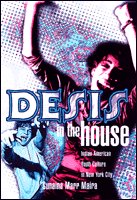
Sunaina Marr Maira: Desis in the House: "Desis in the House
Indian American Youth Culture in New York City
Sunaina Marr Maira
'Desis in the House is what cultural studies ought to be. Sunaina Maira gets deep inside of the social and cultural worlds of second generation Indian Americans and illuminates the links between the local and global, history and nostalgia, nationalism and cosmopolitanism. Maira's perceptive insights into the complex and fluid styles, music, dances, desires and dreams of desi youth will force us all to think about cultural identities in new ways.'
- Robin D. G. Kelley, author of Yo' Mama's DisFunktional! Fighting the Culture Wars in Urban America
She sports a nose-ring and duppata (a scarf worn by South Asian women) along with the latest fashion in slinky club wear; he's decked out in Tommy gear. Their moves on the crowded dance floor, blending Indian film dance with break-dancing, attract no particular attention. They are just two of the hundreds of hip young people who flock to the desi (i.e., South Asian) party scene that flourishes in the Big Apple.
New York City, long the destination for immigrants and migrants, today is home to the largest Indian American population in the United States. Coming of age in a city remarkable for its diversity and cultural innovation, Indian American and other South Asian youth draw on their ethnic traditions and the city's resources to create a vibrant subculture. Some of the city's hottest clubs host regular bhangra parties, weekly events where young South Asians congregate to dance to music that mixes rap beats with Hindi film music, bhangra (North Indian and Pakistani in origin), reggae, techno, and other popular styles. Many of these young people also are active in community and campus organizations that stage performances of "ethnic cultures."
In this book Sunaina Maira explores the world of second-generation Indian American youth to learn how they manage the contradictions of gender roles and sexuality, how they handle their "model minority" status and expectations for class mobility in a society that still racializes everyone in terms of black or white. Maira's deft analysis illuminates the ways in which these young people bridge ethnic authenticity and American "cool."
Excerpt
Read an excerpt from Chapter 1 (pdf).
Reviews
"Sunaina Maira guides us into the bog of nostalgia where beleaguered immigrants of color forge a memory that is at odds with their homeland, but also with the dreams of their home boys and home girls. An honest ethnography gives us ample evidence that nostalgia is a feint. Rather than leave us with this conclusion alone, Maira posits something called critical nostalgia, and you'll find out what that is when you read this important book."—Vijay Prashad, author of Everybody Was Kung Fu Fighting: Afro-Asian Connections and the Myth of Cultural Purity"
1 comment:
nice site!
Post a Comment